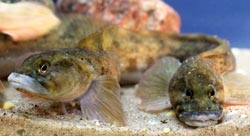An enzyme in fish can demonstrate environmental toxins

Eelpout is a species used in the Swedish monitoring of environmental toxins. Since it is a stationary fish, it can be used to couple local releases of environmental toxins to their effects in exposed animals. Photo: University of Gothenburg/Joachim Sturve<br>
Scientists at the University of Gothenburg can show that CBR has properties that may make it suitable to be used as a biomarker, an early warning signal of environmental toxins. The aim of the project is to achieve better environmental monitoring.
“While chemists measure the levels of environmental toxins, we biologists monitor their effects. We can use biomarkers to discover these effects before the levels of toxins have become fatal. The increased CBR level in fish is probably caused by chemicals in the water. This means that CBR may be a useful biomarker,” says Eva Albertsson, research student in the Department of Zoology at the University of Gothenburg.
Our sewage treatment plants have been designed to remove nutrients from wastewater, but they are not very good at removing many other substances. Fish downstream of the treatment plants thus live in an environment that is filled with both toxic and non-toxic substances. Eva Albertsson's thesis presents work carried out at the Gråbo treatment plant. It turned out that fish downstream of the plant had higher levels of an enzyme, CBR, in the liver than fish living upstream of the plant. Similar effects were seen also at the Borås treatment plant.
It is known that CBR in humans can protect against oxidative stress, which is a harmful reaction that the body activates in response to certain substances. Thus, the elevated levels of CBR we have seen in fish may not be harmful: they may act as protection. The elevated levels, however, may be an indication that there are substances in the cleaned wastewater that cause oxidative stress, which may in the long term develop to give harmful effects.
The substances that cause oxidative stress are present at different levels in some water, such as, for example, the water that is downstream of a sewage treatment plant. Metals, pesticides and substances that form during incomplete combustion are examples of substances that act in such a manner. Eva Albertsson has studied rainbow trout and eelpout, and shown that fish that are exposed to substances known to cause oxidative stress had higher levels of CBR. This means that the enzyme is suitable for use as a biomarker, an early warning signal, that can be used by scientists and authorities whose task is to monitor the effects of environmental toxins.
The thesis From Proteomic Analysis to Biomarker Application – Studies of Carbonyl Reductase in Fish has been successfully defended at a disputation held at the University of Gothenburg.
For more information, please contact: Eva Albertsson
Tel: +46 31 786 3683
Mobile: +46 73 969 6216
E-mail: eva.albertsson@zool.gu.se
Media Contact
All latest news from the category: Life Sciences and Chemistry
Articles and reports from the Life Sciences and chemistry area deal with applied and basic research into modern biology, chemistry and human medicine.
Valuable information can be found on a range of life sciences fields including bacteriology, biochemistry, bionics, bioinformatics, biophysics, biotechnology, genetics, geobotany, human biology, marine biology, microbiology, molecular biology, cellular biology, zoology, bioinorganic chemistry, microchemistry and environmental chemistry.
Newest articles

Superradiant atoms could push the boundaries of how precisely time can be measured
Superradiant atoms can help us measure time more precisely than ever. In a new study, researchers from the University of Copenhagen present a new method for measuring the time interval,…

Ion thermoelectric conversion devices for near room temperature
The electrode sheet of the thermoelectric device consists of ionic hydrogel, which is sandwiched between the electrodes to form, and the Prussian blue on the electrode undergoes a redox reaction…

Zap Energy achieves 37-million-degree temperatures in a compact device
New publication reports record electron temperatures for a small-scale, sheared-flow-stabilized Z-pinch fusion device. In the nine decades since humans first produced fusion reactions, only a few fusion technologies have demonstrated…





















